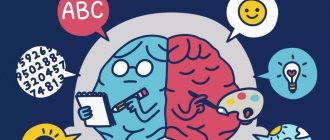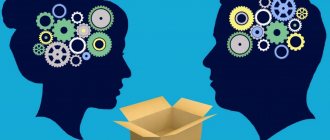Thinking is the main cognitive process that determines much in a person’s life. Associative thinking is a concept that reflects the use of associations: all connections between actions and ideas come from sensations and the traces they leave in the brain. Association is a connection between concepts and ideas that arises in the process of their awareness. One of the ideas evokes another in the mind - this is how associations are born.
Associative connections are not the same for different people, because they depend on personal experience. Thus, one person associates the word “autumn” with slush and bad weather, another – with bright yellow autumn flowers, a third – with a riot of colors in a deciduous forest, a fourth – with mushrooms and “quiet hunting”, a fifth – with loneliness , drizzling rain and a deserted alley stretching into the distance, strewn with withered leaves, and for the sixth - happy birthday, friends, gifts and fun.
The term “association” was introduced by the English philosopher and educator John Locke back in 1698, and has been widely used since then. Thanks to associative thinking, we get acquainted with new things, discover the world for ourselves, expand the boundaries of its knowledge, and learn to think outside the box.
Types of associations
There are different classifications of associations. For example, based on a number of characteristics, the following types can be distinguished:
- Cause - effect (rain - raincoat, lightning - thunder, snow - skis).
- Contiguity, proximity in time and space (sausage - refrigerator, computer - mouse).
- Similarity, similarity of concepts (cloud - feather bed, pear - light bulb).
- Contrast (white - black, fire - ice, cold - heat).
- Generalization (flower - bouquet, birch - tree).
- Submission (vegetable - tomato, bush - viburnum).
- Addition (borscht - sour cream, salad - mayonnaise).
- Whole and parts (body - hand, house - entrance).
- Subordination to one object (pincers - pliers, chair - bench, cup - glass).
There are also associations based on consonance (cat - midge, shadow - fence) and word-forming ones, built on words with the same root (sineva - blue, stove - baking).
In the process of building associations, different senses can be involved, so associations can be gustatory, visual, auditory, olfactory, etc.
Associative theory of thinking
The first ideas about the universal laws of human mental life were associated with the formation of associations . In the 17th century, the psychology of thinking had not yet been identified as a separate section, and thinking was not considered as a special form of human activity. The development of thinking was understood as a process of accumulation of associations.
The associative theory of thinking is one of the earliest. Its supporters believed that thinking is an innate ability and comes down to associations connecting traces of the past and impressions of present experience. Unfortunately, this theory could not explain the creative nature of the thinking process, the specificity of its content and the patterns of its occurrence.
However, based on the learning process, the associative theory of thinking highlighted several very significant points for the development of thinking:
- The importance of using visual material in the learning process;
- The realization that learning is possible only through sensory knowledge, i.e. through images and representations.
- Understanding that associations expand the boundaries of abilities, through them consciousness is stimulated, activating the processes of comparison, analysis, and generalization.
What it is?
The basis of associative thinking is the connection between concepts expressed in words. In this case, consciousness easily processes incoming information without the use of logical analysis. Perception of the world, generation of ideas and decision making are inextricably linked with associative thinking. Whether a person is well or poorly developed depends on attention, perception, memory and life experience.
During an acquaintance with a new phenomenon, object, or person, the individual’s brain begins to work intensely. A mental comparison with already familiar concepts occurs instantly, and specific associations arise. At the next meeting, recognition occurs with the help of previously built associative connections.
The more associations that come to mind, the easier it is to remember and reflect. The ability to think figuratively improves the quality of this process.
How does associative thinking work? Let's imagine this situation: for the first time seeing the northern lights in person, a person mentally compares it with fireworks, salutes or multi-colored lightning. He associates the slight crackling sound that accompanies this stunning spectacle with the crackling of wood in a village stove. And the timbre of a new acquaintance’s voice resembles the pleasant baritone of a colleague, the oval face of a neighbor, the gait of a childhood friend, the name and patronymic coincide with those of a famous writer.
Associative thinking gives a person a number of advantages. With his help:
- brain function is stimulated;
- memory is strengthened;
- imagination improves;
- an extraordinary fantasy is formed;
- the productivity of cognitive processes increases;
- the perception of new information is facilitated;
- adaptation to extraordinary situations and any life changes increases;
- voluntary attention develops;
- the search for solutions to non-standard problems is facilitated;
- new semantic connections are formed;
- unusual ideas are created;
- creative abilities are fully manifested.
Development of associative thinking
Ideas suggested by associations have been successfully used by people for a long time. Observations of fish gave rise to the idea of creating a submarine, and the ascent and submersion systems were inspired by associations with the air bladder of a fish. The idea of echolocation was borrowed from dolphins. The burdock clinging to the dog's fur suggested to Georges de Menstral, an engineer from Switzerland, the principle of creating Velcro, which is now widely used in clothing and shoes. Many unrealized ideas suggested by associations were preserved in the notebooks of Leonardo Da Vinci. Thus, bird observations suggested to him the idea of an ornithopter, which would allow a person to soar above the ground. His sketches of a parachute are a reflection of the dream of a flying man, drifting in the heights, not afraid to fall from any height. And this is only a tiny part of the ideas inspired by associations, and the main thing is that this process cannot be stopped.
Developed associative thinking gives us a number of advantages:
- promotes the development of imagination;
- helps generate new, extraordinary ideas;
- facilitates perception and promotes the formation of new semantic connections;
- improves adaptation to new, non-standard situations and helps in finding solutions to unusual problems;
- stimulates brain function;
- improves memory capacity.
It is impossible not to mention that the basis of mnemonics, which allows you to memorize large volumes of words, are associations. You can learn more about associative memory in our article Associative Memory. Development of associative memory.
It is better to begin the development of associative thinking from early childhood, step by step. First, you just need to introduce the child to all the concepts encountered and the actions associated with them. The next stage is teaching the child to generalize. For example, cups, plates, saucers - dishes; chair, table, armchair - furniture; car, doll, cubes - toys. At the same time, the child learns to name and distinguish objects.
For older children, other, more complex exercises are needed: drawing up associative series, searching for a sequence in a word series, analyzing objects by attribute.
A child’s associative thinking can lead him to psychologically difficult situations. For a parent, in the case when a child reacts sharply negatively to an image or association (for example, vaccination - injection - doctor - white coat), it is important to understand that suppressed associations driven “into a dark corner” can cause the development of various kinds of complexes in the future. It is important to be patient, talk to your child about what scares him, explain, and be positive. You should listen to the child and his associations, try to understand his needs, images, aspirations in order to support the child, reassure him, and restore his sense of security.
Some general information
Each person’s associations with one word or event are completely different. This happens due to the life experience that is behind us. For example, when hearing the word “sun,” someone may smile joyfully, remembering the happiest day when the sun was shining brightly and it was warm. And someone, on the contrary, will frown, remembering how he got burns in the summer, in addition to sunstroke due to falling asleep on the beach.
And also due to the difference in the leading representative system. Let me briefly remind you that there are auditory learners; it is easier for them to remember and perceive information by ear. Kinesthetics, they do this with the help of sensations and touches. Visual people rely on their vision, it is important for them to see, only then will they be able to notice and remember something. And also a rare type of digitals, they combined all the features of the representative system, taking a little from each type.
So, we build associations depending on what organs of perception we use to perceive this world and exist in it. Let's say that to learn a phone number, you just need to say it out loud several times. But another person will not be able to reproduce it until he writes it down on a piece of paper, or imagines each number in his head.
Exercises for developing associative thinking
Want to try association games? This is the case when games develop:
- Take any two words that are not related in meaning, and try to gradually create a semantic associative chain leading from one to the other. For example: a car and a tree. The chain could be like this: car – road – forest – tree.
- Think of a few words (for example: bottle, beads, window). Choose association words for them that are similar in one or more characteristics (for example: glass, hard, sparkling, green).
- Choose associations that unite all the words at the same time. For example: cold, shiny - ice, diamond, metal.
- If you are on a walk or on the road, and you have a travel companion, come up with any first word and, in turn, lead a chain of associations from it. When an association is not clear, explain its appearance. It's fun, interesting and develops associative thinking.
- Come up with unusual associations. For example, wallet - money is a common, expected association. What else can you keep in your wallet? A lottery ticket, a lock of hair, an amulet, a note, a key?
- There is an interesting test that does not take much time, but allows you to play with associations and look into your subconscious and understand what is bothering you. This is the first step towards a solution, right? You can simply come up with 16 any words, or you can use auxiliary initial letters. But you shouldn’t think for a long time, you need to write the first thing that comes to mind and be honest with yourself (if your goal is to get to know yourself better and solve your problem). You can use nouns, adjectives, adverbs, phrases. So, if you decide to use letters (it’s easier to start with), take a piece of paper and write down the following letters vertically on the left: t, d, b, m, g, a, g, o, k, p, c, n, z , p, l, s. Now, opposite each of them, write a word starting with that letter - the first one that comes to mind. Now take the resulting words in pairs, selecting an association for every two consecutive words running vertically. Write down associations next to each pair of words. You will get 8 words. Then again, vertically from top to bottom, combine the two resulting words and again write down the emerging associations. Now there will be 4 of them. Combine them in pairs, write down two new associations. By combining them, you get the key association, the most important one. Associations helped in the study of the subconscious, they were used by S. Freud, then by C. Jung, and are still used by many psychoanalysts (and not only to this day). By using the creative component of your personality, during such a test you can look into your subconscious and find ways to solve the problem, if any. In any case, by putting associations and thoughts on paper, we subject them to analysis, look deeper into ourselves and understand better.
Tips and tricks
Bright and unusual events are best fixed in a person’s memory. They should touch various senses. Associations must generate genuine interest. They need to be well understood and endowed with certain details: color, size, shape. Reading a variety of literature has a beneficial effect on the associative thought process.
It is believed that in women the associative thought process occurs faster than logical thinking. Men have a more developed spatial indicator. Experts recommend that they use creative notebooks. There are ready-made printed publications for creative people with tasks that develop associative thinking.
Psychological terms Author of the article: Ivan Ivanovich Ivanov Ivanov I. I. —>
Contents of the article:
The famous Italian writer Gianni Rodari, using a romantic comparison, showed how an association is formed. He compared the spoken word to a stone thrown into a river. The stone made waves on the water, which made everything in it sway: a leaf, a reed, a water lily, a fishing rod float. Only waves from the spoken word arise in our cerebral cortex; what you hear evokes images, memories, thoughts.
Impaired associative thinking
Violations of associative thinking are expressed in changes in its pace, focus and harmony. Serious painful disorders of associative thinking are the subject of study in the literature on psychiatry and clinical psychology, in the section of psychopathology.
Some patterns of disturbances in the thought process were identified. Based on the symptoms of disorders, disorders are divided, for example, into form and content. In the first case, we are talking about violations of the associative process of thinking (the way a person thinks), and in the second - violations of judgment (what a person thinks, various kinds of obsessive states, delusions, super-black ideas). Below we will consider only some types of disorders of associative thinking:
1. By changing the pace of thinking:
- Acceleration, a noticeably faster pace of processing information, generating ideas, making decisions, and sometimes a leap of ideas. This acceleration is characteristic of manic states.
- Slowing down the pace, excessive delay in thinking and making decisions.
- An involuntary intrusion of thoughts (mentism), interfering with the thought process, leading off the topic.
- Stopping thinking is a break in the flow of thoughts, their involuntary stop.
2. By mobility, liveliness of the thinking process:
- An abundance of detail, minor details, unimportant to the topic.
- Excessive thoroughness, aggravating the previous point with unnecessary distracting associations and details.
- The viscosity of thoughts, in which thinking ceases to be productive, the thread of conversation is lost.
3. According to the grammatical structure of speech:
- The use of cliches, ready-made cliches, templates or questions when constructing an answer, that is, the use of speech stereotypes.
- Repeating meaningless words, sounds or phrases.
- Incoherent repetition of words or their combinations, in which there is no logical or grammatical structure.
4. By focus:
- Excessive ornateness when expressing a simple thought.
- Slipping off the topic into a lengthy discussion on an abstract association, followed by a return to the topic.
- Verbose empty and lengthy ranting without purpose, “about nothing” (reasoning).
- Directing efforts not at resolving the issue, but at executing the protocol (formalism).
- Consideration of an issue from different angles, with different evaluation criteria, changing levels of generalization, which makes it impossible to make a final decision (diversity).
- Fuzzy, contradictory use of concepts, when it is almost impossible to understand what is being said (amorphousness).
- Violations of the logic of thinking, in which either premises, or cause-and-effect relationships, or evidence suffer.
- Symbolism that is understandable only to the patient himself, and to no one else.
- Pathological finding of new meanings in words, based, for example, on the number of letters or on their rhyming with one or another (for example, “happy” or “unlucky”) word.
- Autistic thinking is one that concerns only the patient’s inner world, closed to outsiders.
- Archaic thinking - it is based on ancient stereotypes, judgments, views that are far from modernity.
- Perseveration (persistence, persistence) - in this case, a person persistently repeats words, phrases or deeds, even if the relevant context has already been exhausted.
- Discontinuity (lack of logical connection between concepts, judgments and conclusions), although the grammatical structure of speech may not be disrupted.
To keep the brain in good shape, the comprehensive development of its cognitive functions, such as attention, thinking, memory and perception, is important. To develop them, you can use regular classes with the help of exciting online games performed in the form of exercises for the development of thinking in adults.
We sincerely wish you a useful and exciting pastime and success in self-development!
Scope of application
Imaginative or associative thinking contributes to better assimilation of new information. You will be able not only to generate creative ideas, but also to actively implement them. This will help you achieve success in work and school.
Associative thinking is most useful to people in creative professions. We are talking about musicians, actors, writers. Marketers also use it. They need associations in order to make buyers want to purchase a particular product. They create the most simple but memorable images. And you, without noticing it, go to the store for the next new product.








